HLTWHS001 Participate in Workplace Health and Safety: Assignment
VerifiedAdded on 2023/06/11
|9
|1930
|297
Homework Assignment
AI Summary
This assignment solution provides detailed answers to questions related to workplace health and safety, specifically addressing the HLTWHS001 unit. It covers topics such as identifying and controlling workplace hazards like bloodborne pathogens and sharps injuries, creating action plans for promoting workplace safety, the roles and responsibilities of Health and Safety Representatives (HSRs) and Health and Safety Committees (HSCs), and the legal responsibilities of workers in relation to WHS. The solution also includes practical advice on addressing safety concerns in the workplace, such as advising colleagues on safe work practices and handling incidents like client injuries due to workplace hazards. Furthermore, it emphasizes the importance of adhering to relevant legislation like the Work Health and Safety Act 2011 and ensuring workplaces maintain up-to-date WHS standards. This document is designed to assist students in understanding and applying key concepts of workplace health and safety.
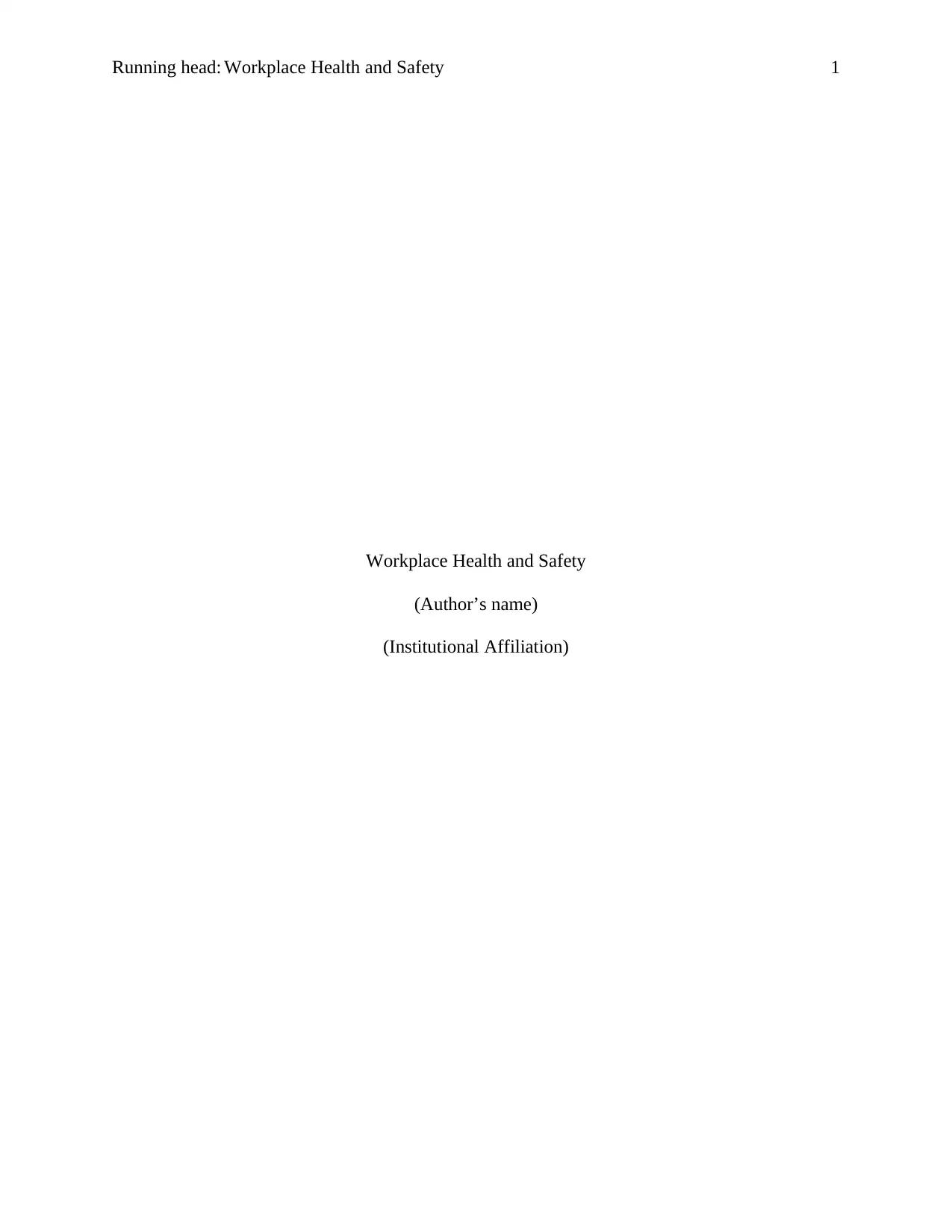
Running head: Workplace Health and Safety 1
Workplace Health and Safety
(Author’s name)
(Institutional Affiliation)
Workplace Health and Safety
(Author’s name)
(Institutional Affiliation)
Paraphrase This Document
Need a fresh take? Get an instant paraphrase of this document with our AI Paraphraser
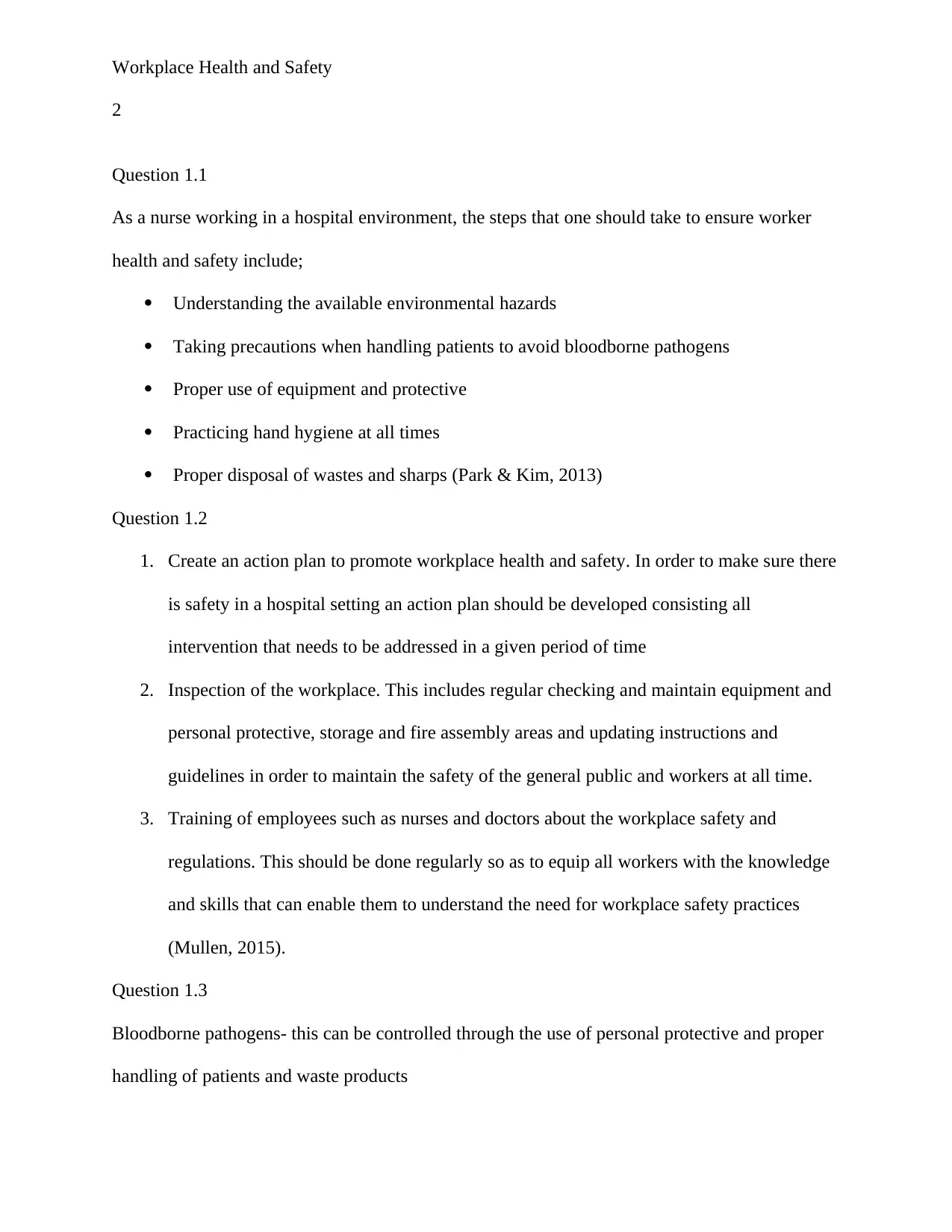
Workplace Health and Safety
2
Question 1.1
As a nurse working in a hospital environment, the steps that one should take to ensure worker
health and safety include;
Understanding the available environmental hazards
Taking precautions when handling patients to avoid bloodborne pathogens
Proper use of equipment and protective
Practicing hand hygiene at all times
Proper disposal of wastes and sharps (Park & Kim, 2013)
Question 1.2
1. Create an action plan to promote workplace health and safety. In order to make sure there
is safety in a hospital setting an action plan should be developed consisting all
intervention that needs to be addressed in a given period of time
2. Inspection of the workplace. This includes regular checking and maintain equipment and
personal protective, storage and fire assembly areas and updating instructions and
guidelines in order to maintain the safety of the general public and workers at all time.
3. Training of employees such as nurses and doctors about the workplace safety and
regulations. This should be done regularly so as to equip all workers with the knowledge
and skills that can enable them to understand the need for workplace safety practices
(Mullen, 2015).
Question 1.3
Bloodborne pathogens- this can be controlled through the use of personal protective and proper
handling of patients and waste products
2
Question 1.1
As a nurse working in a hospital environment, the steps that one should take to ensure worker
health and safety include;
Understanding the available environmental hazards
Taking precautions when handling patients to avoid bloodborne pathogens
Proper use of equipment and protective
Practicing hand hygiene at all times
Proper disposal of wastes and sharps (Park & Kim, 2013)
Question 1.2
1. Create an action plan to promote workplace health and safety. In order to make sure there
is safety in a hospital setting an action plan should be developed consisting all
intervention that needs to be addressed in a given period of time
2. Inspection of the workplace. This includes regular checking and maintain equipment and
personal protective, storage and fire assembly areas and updating instructions and
guidelines in order to maintain the safety of the general public and workers at all time.
3. Training of employees such as nurses and doctors about the workplace safety and
regulations. This should be done regularly so as to equip all workers with the knowledge
and skills that can enable them to understand the need for workplace safety practices
(Mullen, 2015).
Question 1.3
Bloodborne pathogens- this can be controlled through the use of personal protective and proper
handling of patients and waste products
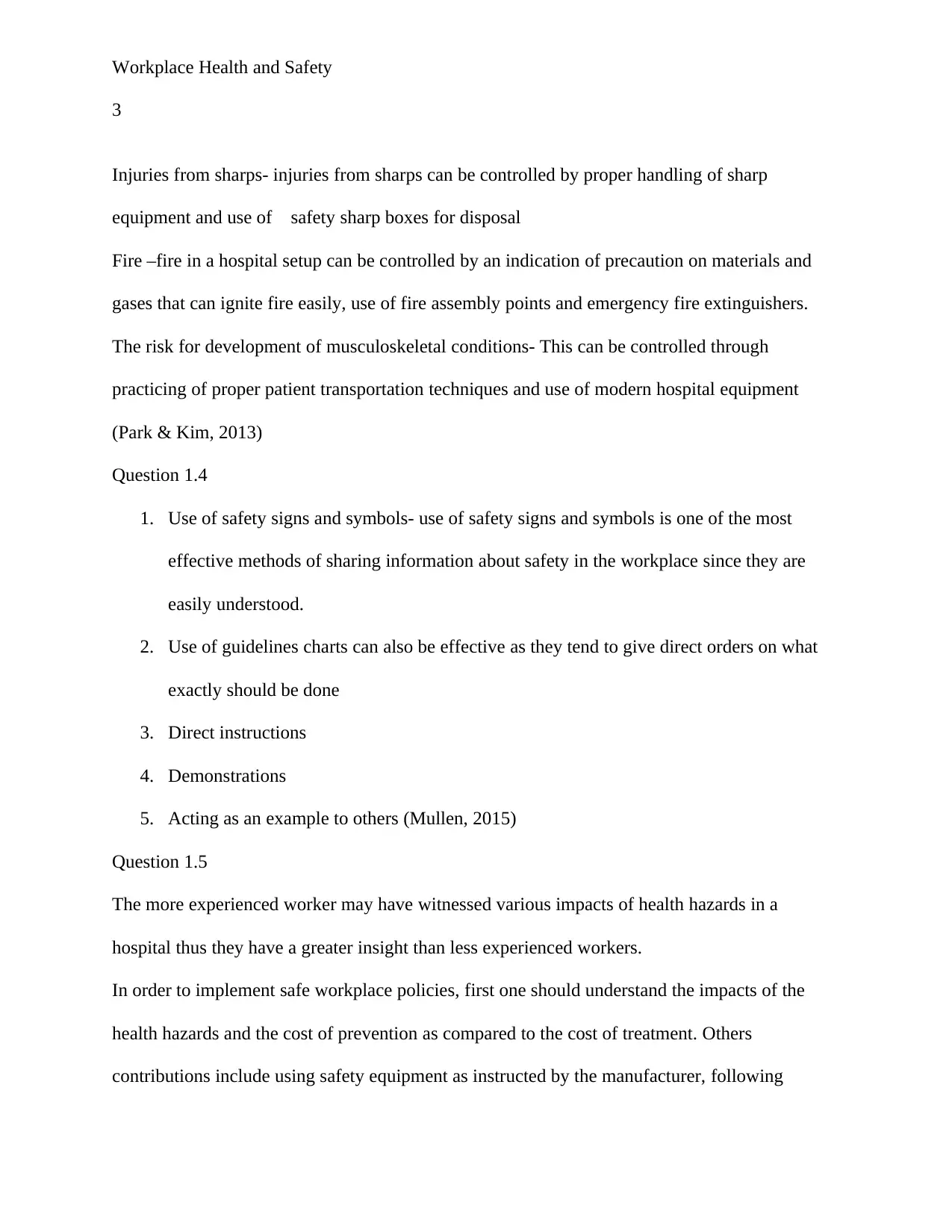
Workplace Health and Safety
3
Injuries from sharps- injuries from sharps can be controlled by proper handling of sharp
equipment and use of safety sharp boxes for disposal
Fire –fire in a hospital setup can be controlled by an indication of precaution on materials and
gases that can ignite fire easily, use of fire assembly points and emergency fire extinguishers.
The risk for development of musculoskeletal conditions- This can be controlled through
practicing of proper patient transportation techniques and use of modern hospital equipment
(Park & Kim, 2013)
Question 1.4
1. Use of safety signs and symbols- use of safety signs and symbols is one of the most
effective methods of sharing information about safety in the workplace since they are
easily understood.
2. Use of guidelines charts can also be effective as they tend to give direct orders on what
exactly should be done
3. Direct instructions
4. Demonstrations
5. Acting as an example to others (Mullen, 2015)
Question 1.5
The more experienced worker may have witnessed various impacts of health hazards in a
hospital thus they have a greater insight than less experienced workers.
In order to implement safe workplace policies, first one should understand the impacts of the
health hazards and the cost of prevention as compared to the cost of treatment. Others
contributions include using safety equipment as instructed by the manufacturer, following
3
Injuries from sharps- injuries from sharps can be controlled by proper handling of sharp
equipment and use of safety sharp boxes for disposal
Fire –fire in a hospital setup can be controlled by an indication of precaution on materials and
gases that can ignite fire easily, use of fire assembly points and emergency fire extinguishers.
The risk for development of musculoskeletal conditions- This can be controlled through
practicing of proper patient transportation techniques and use of modern hospital equipment
(Park & Kim, 2013)
Question 1.4
1. Use of safety signs and symbols- use of safety signs and symbols is one of the most
effective methods of sharing information about safety in the workplace since they are
easily understood.
2. Use of guidelines charts can also be effective as they tend to give direct orders on what
exactly should be done
3. Direct instructions
4. Demonstrations
5. Acting as an example to others (Mullen, 2015)
Question 1.5
The more experienced worker may have witnessed various impacts of health hazards in a
hospital thus they have a greater insight than less experienced workers.
In order to implement safe workplace policies, first one should understand the impacts of the
health hazards and the cost of prevention as compared to the cost of treatment. Others
contributions include using safety equipment as instructed by the manufacturer, following
⊘ This is a preview!⊘
Do you want full access?
Subscribe today to unlock all pages.

Trusted by 1+ million students worldwide
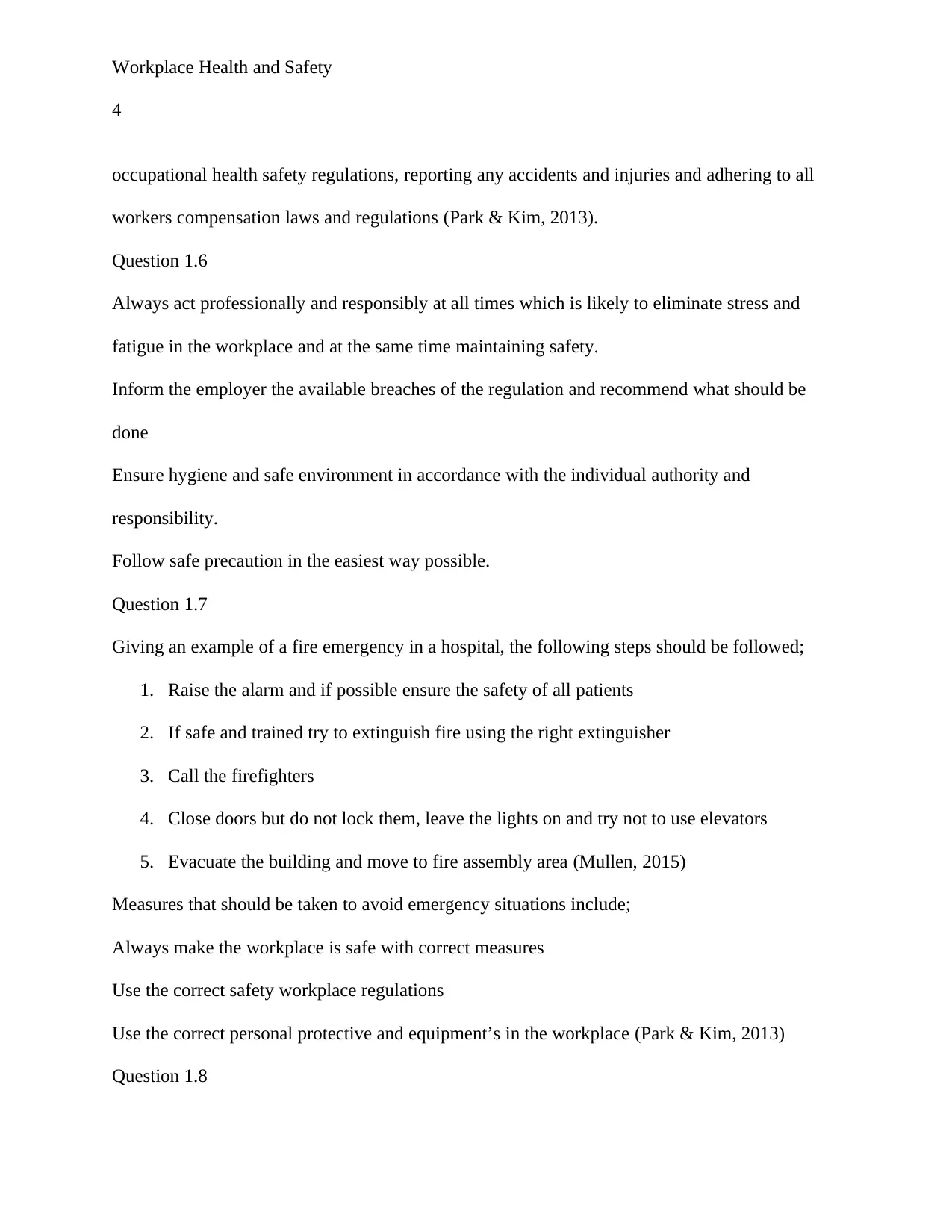
Workplace Health and Safety
4
occupational health safety regulations, reporting any accidents and injuries and adhering to all
workers compensation laws and regulations (Park & Kim, 2013).
Question 1.6
Always act professionally and responsibly at all times which is likely to eliminate stress and
fatigue in the workplace and at the same time maintaining safety.
Inform the employer the available breaches of the regulation and recommend what should be
done
Ensure hygiene and safe environment in accordance with the individual authority and
responsibility.
Follow safe precaution in the easiest way possible.
Question 1.7
Giving an example of a fire emergency in a hospital, the following steps should be followed;
1. Raise the alarm and if possible ensure the safety of all patients
2. If safe and trained try to extinguish fire using the right extinguisher
3. Call the firefighters
4. Close doors but do not lock them, leave the lights on and try not to use elevators
5. Evacuate the building and move to fire assembly area (Mullen, 2015)
Measures that should be taken to avoid emergency situations include;
Always make the workplace is safe with correct measures
Use the correct safety workplace regulations
Use the correct personal protective and equipment’s in the workplace (Park & Kim, 2013)
Question 1.8
4
occupational health safety regulations, reporting any accidents and injuries and adhering to all
workers compensation laws and regulations (Park & Kim, 2013).
Question 1.6
Always act professionally and responsibly at all times which is likely to eliminate stress and
fatigue in the workplace and at the same time maintaining safety.
Inform the employer the available breaches of the regulation and recommend what should be
done
Ensure hygiene and safe environment in accordance with the individual authority and
responsibility.
Follow safe precaution in the easiest way possible.
Question 1.7
Giving an example of a fire emergency in a hospital, the following steps should be followed;
1. Raise the alarm and if possible ensure the safety of all patients
2. If safe and trained try to extinguish fire using the right extinguisher
3. Call the firefighters
4. Close doors but do not lock them, leave the lights on and try not to use elevators
5. Evacuate the building and move to fire assembly area (Mullen, 2015)
Measures that should be taken to avoid emergency situations include;
Always make the workplace is safe with correct measures
Use the correct safety workplace regulations
Use the correct personal protective and equipment’s in the workplace (Park & Kim, 2013)
Question 1.8
Paraphrase This Document
Need a fresh take? Get an instant paraphrase of this document with our AI Paraphraser
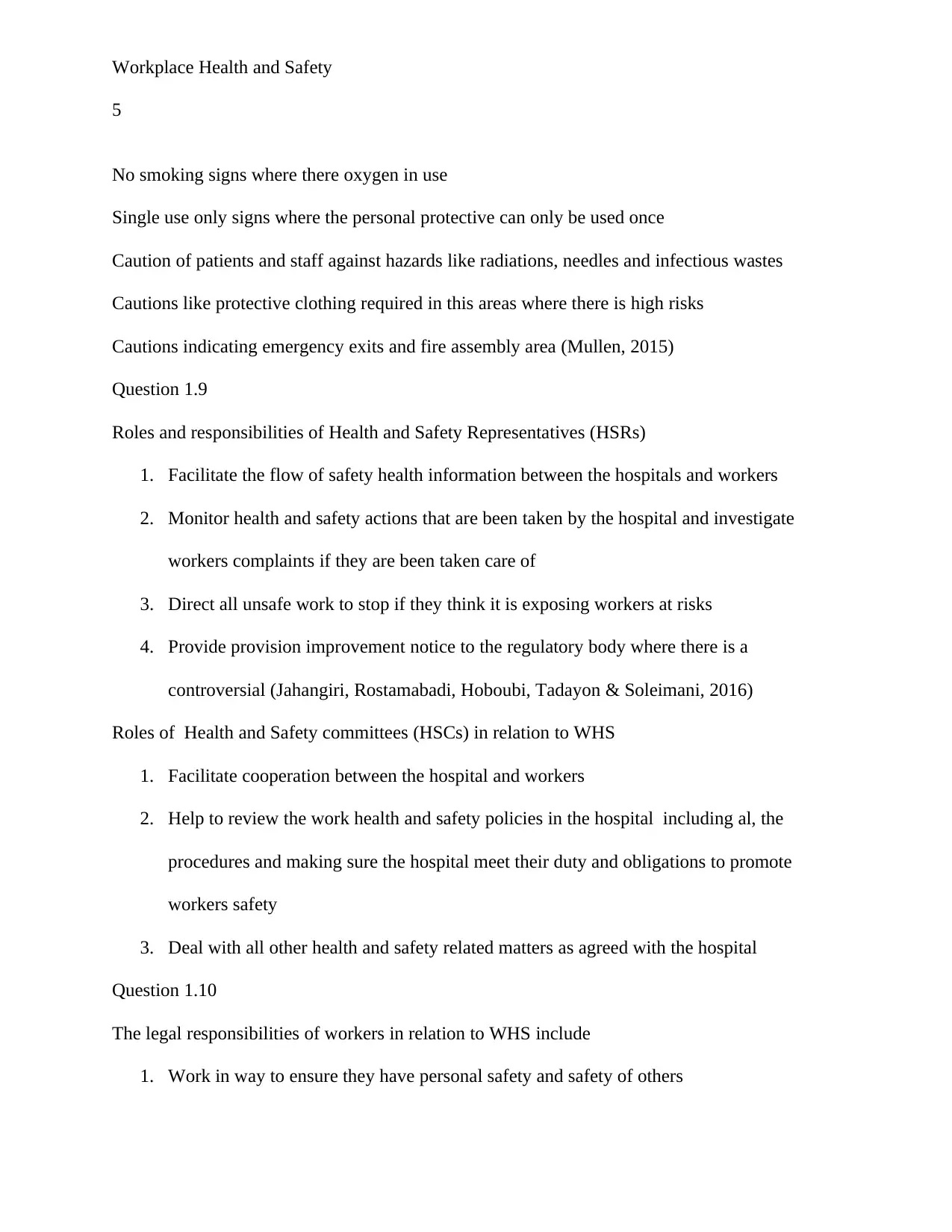
Workplace Health and Safety
5
No smoking signs where there oxygen in use
Single use only signs where the personal protective can only be used once
Caution of patients and staff against hazards like radiations, needles and infectious wastes
Cautions like protective clothing required in this areas where there is high risks
Cautions indicating emergency exits and fire assembly area (Mullen, 2015)
Question 1.9
Roles and responsibilities of Health and Safety Representatives (HSRs)
1. Facilitate the flow of safety health information between the hospitals and workers
2. Monitor health and safety actions that are been taken by the hospital and investigate
workers complaints if they are been taken care of
3. Direct all unsafe work to stop if they think it is exposing workers at risks
4. Provide provision improvement notice to the regulatory body where there is a
controversial (Jahangiri, Rostamabadi, Hoboubi, Tadayon & Soleimani, 2016)
Roles of Health and Safety committees (HSCs) in relation to WHS
1. Facilitate cooperation between the hospital and workers
2. Help to review the work health and safety policies in the hospital including al, the
procedures and making sure the hospital meet their duty and obligations to promote
workers safety
3. Deal with all other health and safety related matters as agreed with the hospital
Question 1.10
The legal responsibilities of workers in relation to WHS include
1. Work in way to ensure they have personal safety and safety of others
5
No smoking signs where there oxygen in use
Single use only signs where the personal protective can only be used once
Caution of patients and staff against hazards like radiations, needles and infectious wastes
Cautions like protective clothing required in this areas where there is high risks
Cautions indicating emergency exits and fire assembly area (Mullen, 2015)
Question 1.9
Roles and responsibilities of Health and Safety Representatives (HSRs)
1. Facilitate the flow of safety health information between the hospitals and workers
2. Monitor health and safety actions that are been taken by the hospital and investigate
workers complaints if they are been taken care of
3. Direct all unsafe work to stop if they think it is exposing workers at risks
4. Provide provision improvement notice to the regulatory body where there is a
controversial (Jahangiri, Rostamabadi, Hoboubi, Tadayon & Soleimani, 2016)
Roles of Health and Safety committees (HSCs) in relation to WHS
1. Facilitate cooperation between the hospital and workers
2. Help to review the work health and safety policies in the hospital including al, the
procedures and making sure the hospital meet their duty and obligations to promote
workers safety
3. Deal with all other health and safety related matters as agreed with the hospital
Question 1.10
The legal responsibilities of workers in relation to WHS include
1. Work in way to ensure they have personal safety and safety of others
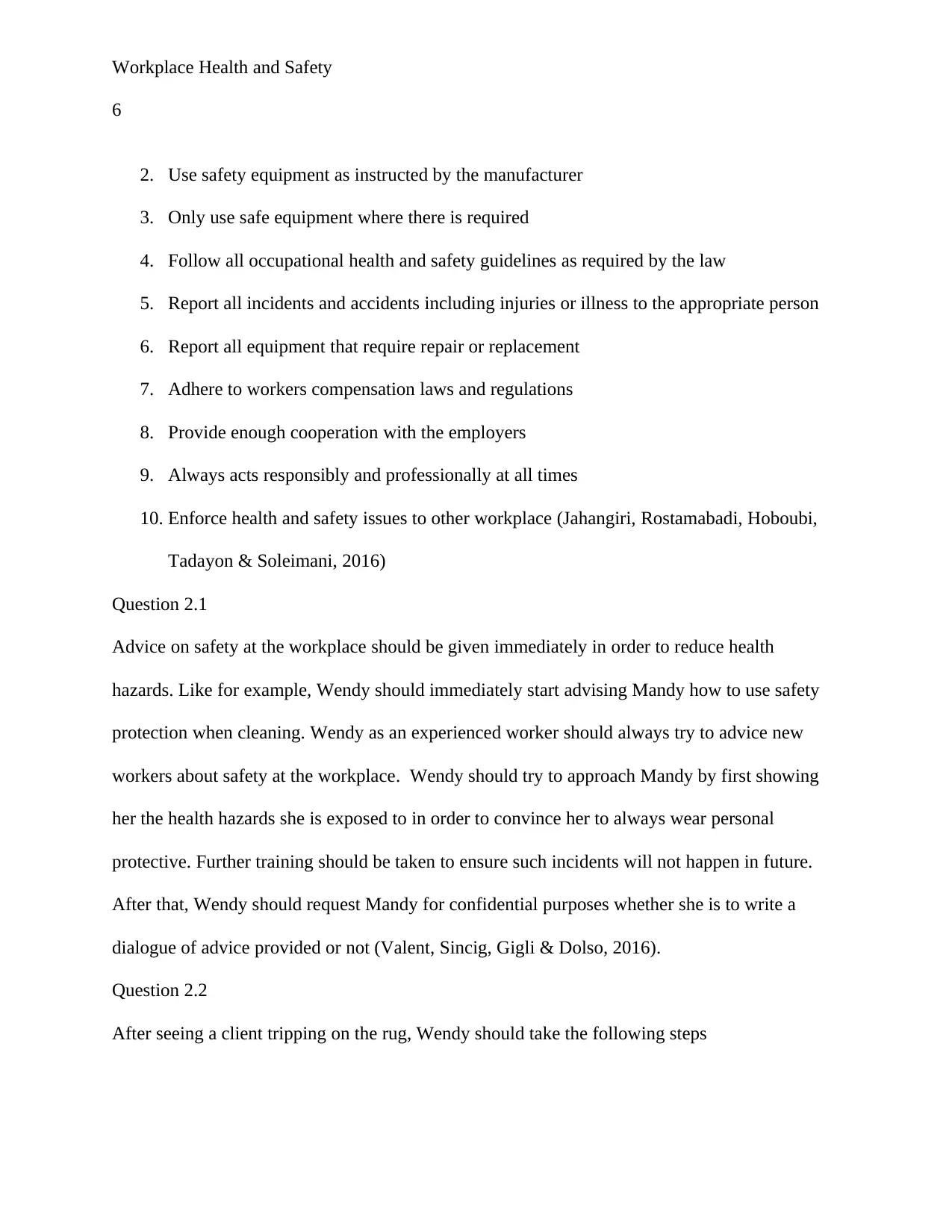
Workplace Health and Safety
6
2. Use safety equipment as instructed by the manufacturer
3. Only use safe equipment where there is required
4. Follow all occupational health and safety guidelines as required by the law
5. Report all incidents and accidents including injuries or illness to the appropriate person
6. Report all equipment that require repair or replacement
7. Adhere to workers compensation laws and regulations
8. Provide enough cooperation with the employers
9. Always acts responsibly and professionally at all times
10. Enforce health and safety issues to other workplace (Jahangiri, Rostamabadi, Hoboubi,
Tadayon & Soleimani, 2016)
Question 2.1
Advice on safety at the workplace should be given immediately in order to reduce health
hazards. Like for example, Wendy should immediately start advising Mandy how to use safety
protection when cleaning. Wendy as an experienced worker should always try to advice new
workers about safety at the workplace. Wendy should try to approach Mandy by first showing
her the health hazards she is exposed to in order to convince her to always wear personal
protective. Further training should be taken to ensure such incidents will not happen in future.
After that, Wendy should request Mandy for confidential purposes whether she is to write a
dialogue of advice provided or not (Valent, Sincig, Gigli & Dolso, 2016).
Question 2.2
After seeing a client tripping on the rug, Wendy should take the following steps
6
2. Use safety equipment as instructed by the manufacturer
3. Only use safe equipment where there is required
4. Follow all occupational health and safety guidelines as required by the law
5. Report all incidents and accidents including injuries or illness to the appropriate person
6. Report all equipment that require repair or replacement
7. Adhere to workers compensation laws and regulations
8. Provide enough cooperation with the employers
9. Always acts responsibly and professionally at all times
10. Enforce health and safety issues to other workplace (Jahangiri, Rostamabadi, Hoboubi,
Tadayon & Soleimani, 2016)
Question 2.1
Advice on safety at the workplace should be given immediately in order to reduce health
hazards. Like for example, Wendy should immediately start advising Mandy how to use safety
protection when cleaning. Wendy as an experienced worker should always try to advice new
workers about safety at the workplace. Wendy should try to approach Mandy by first showing
her the health hazards she is exposed to in order to convince her to always wear personal
protective. Further training should be taken to ensure such incidents will not happen in future.
After that, Wendy should request Mandy for confidential purposes whether she is to write a
dialogue of advice provided or not (Valent, Sincig, Gigli & Dolso, 2016).
Question 2.2
After seeing a client tripping on the rug, Wendy should take the following steps
⊘ This is a preview!⊘
Do you want full access?
Subscribe today to unlock all pages.

Trusted by 1+ million students worldwide
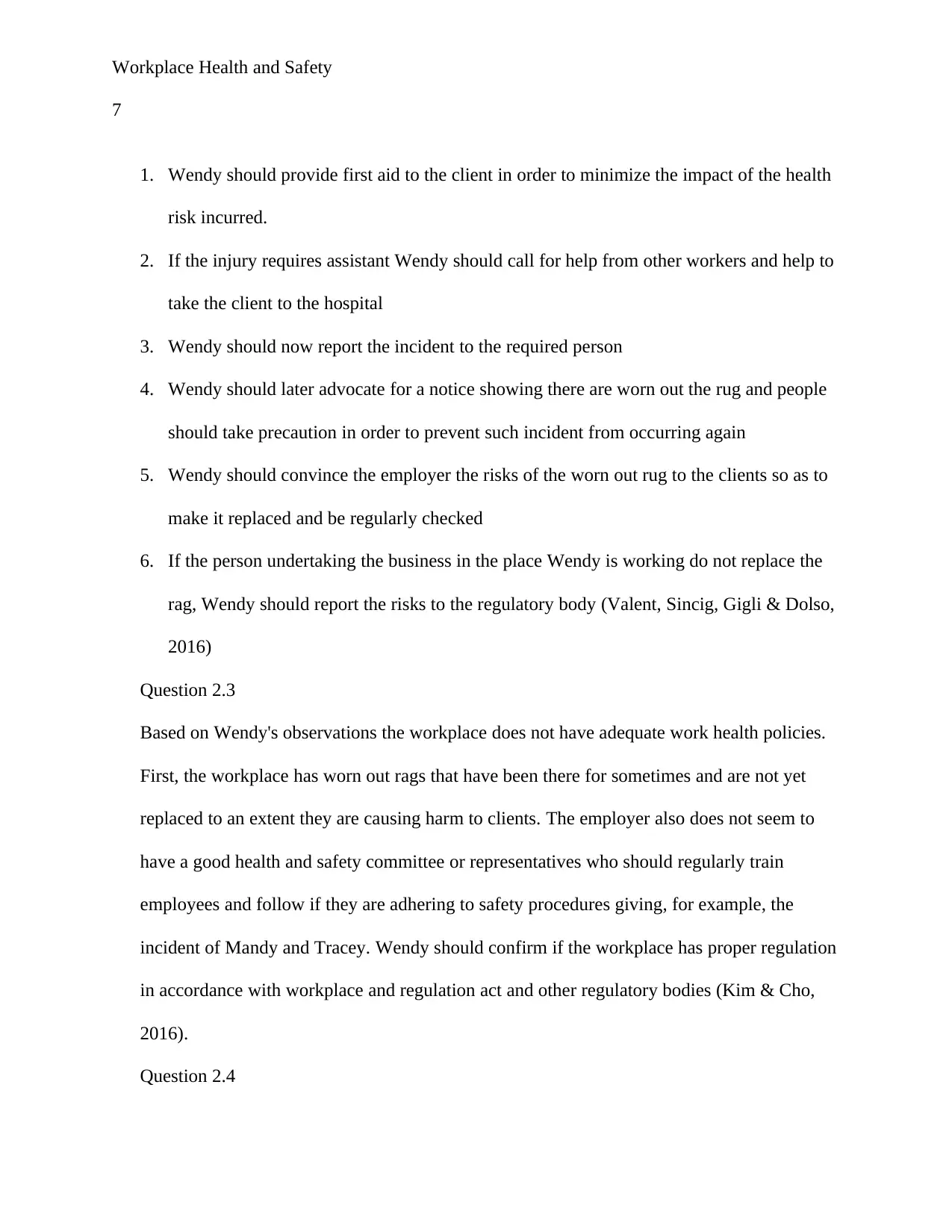
Workplace Health and Safety
7
1. Wendy should provide first aid to the client in order to minimize the impact of the health
risk incurred.
2. If the injury requires assistant Wendy should call for help from other workers and help to
take the client to the hospital
3. Wendy should now report the incident to the required person
4. Wendy should later advocate for a notice showing there are worn out the rug and people
should take precaution in order to prevent such incident from occurring again
5. Wendy should convince the employer the risks of the worn out rug to the clients so as to
make it replaced and be regularly checked
6. If the person undertaking the business in the place Wendy is working do not replace the
rag, Wendy should report the risks to the regulatory body (Valent, Sincig, Gigli & Dolso,
2016)
Question 2.3
Based on Wendy's observations the workplace does not have adequate work health policies.
First, the workplace has worn out rags that have been there for sometimes and are not yet
replaced to an extent they are causing harm to clients. The employer also does not seem to
have a good health and safety committee or representatives who should regularly train
employees and follow if they are adhering to safety procedures giving, for example, the
incident of Mandy and Tracey. Wendy should confirm if the workplace has proper regulation
in accordance with workplace and regulation act and other regulatory bodies (Kim & Cho,
2016).
Question 2.4
7
1. Wendy should provide first aid to the client in order to minimize the impact of the health
risk incurred.
2. If the injury requires assistant Wendy should call for help from other workers and help to
take the client to the hospital
3. Wendy should now report the incident to the required person
4. Wendy should later advocate for a notice showing there are worn out the rug and people
should take precaution in order to prevent such incident from occurring again
5. Wendy should convince the employer the risks of the worn out rug to the clients so as to
make it replaced and be regularly checked
6. If the person undertaking the business in the place Wendy is working do not replace the
rag, Wendy should report the risks to the regulatory body (Valent, Sincig, Gigli & Dolso,
2016)
Question 2.3
Based on Wendy's observations the workplace does not have adequate work health policies.
First, the workplace has worn out rags that have been there for sometimes and are not yet
replaced to an extent they are causing harm to clients. The employer also does not seem to
have a good health and safety committee or representatives who should regularly train
employees and follow if they are adhering to safety procedures giving, for example, the
incident of Mandy and Tracey. Wendy should confirm if the workplace has proper regulation
in accordance with workplace and regulation act and other regulatory bodies (Kim & Cho,
2016).
Question 2.4
Paraphrase This Document
Need a fresh take? Get an instant paraphrase of this document with our AI Paraphraser
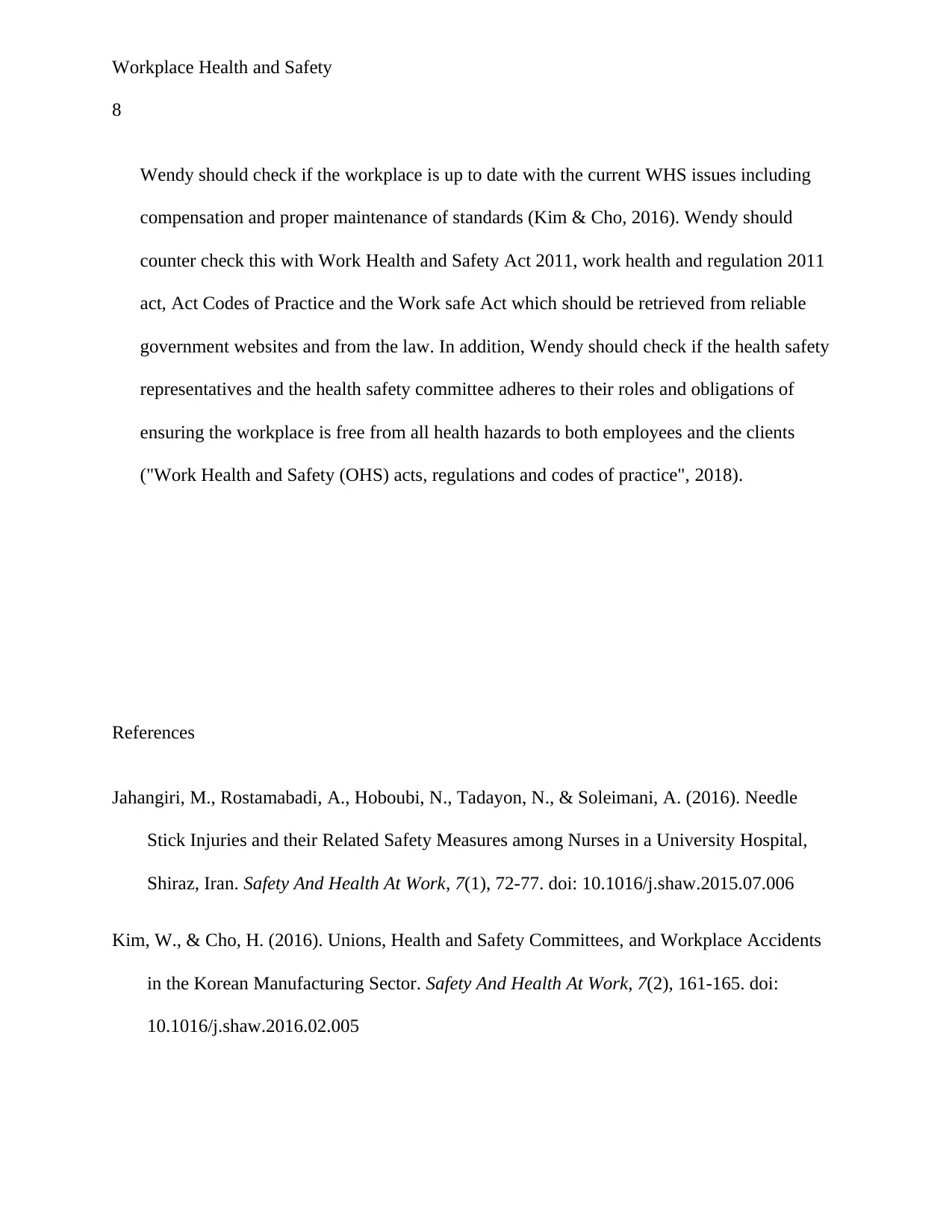
Workplace Health and Safety
8
Wendy should check if the workplace is up to date with the current WHS issues including
compensation and proper maintenance of standards (Kim & Cho, 2016). Wendy should
counter check this with Work Health and Safety Act 2011, work health and regulation 2011
act, Act Codes of Practice and the Work safe Act which should be retrieved from reliable
government websites and from the law. In addition, Wendy should check if the health safety
representatives and the health safety committee adheres to their roles and obligations of
ensuring the workplace is free from all health hazards to both employees and the clients
("Work Health and Safety (OHS) acts, regulations and codes of practice", 2018).
References
Jahangiri, M., Rostamabadi, A., Hoboubi, N., Tadayon, N., & Soleimani, A. (2016). Needle
Stick Injuries and their Related Safety Measures among Nurses in a University Hospital,
Shiraz, Iran. Safety And Health At Work, 7(1), 72-77. doi: 10.1016/j.shaw.2015.07.006
Kim, W., & Cho, H. (2016). Unions, Health and Safety Committees, and Workplace Accidents
in the Korean Manufacturing Sector. Safety And Health At Work, 7(2), 161-165. doi:
10.1016/j.shaw.2016.02.005
8
Wendy should check if the workplace is up to date with the current WHS issues including
compensation and proper maintenance of standards (Kim & Cho, 2016). Wendy should
counter check this with Work Health and Safety Act 2011, work health and regulation 2011
act, Act Codes of Practice and the Work safe Act which should be retrieved from reliable
government websites and from the law. In addition, Wendy should check if the health safety
representatives and the health safety committee adheres to their roles and obligations of
ensuring the workplace is free from all health hazards to both employees and the clients
("Work Health and Safety (OHS) acts, regulations and codes of practice", 2018).
References
Jahangiri, M., Rostamabadi, A., Hoboubi, N., Tadayon, N., & Soleimani, A. (2016). Needle
Stick Injuries and their Related Safety Measures among Nurses in a University Hospital,
Shiraz, Iran. Safety And Health At Work, 7(1), 72-77. doi: 10.1016/j.shaw.2015.07.006
Kim, W., & Cho, H. (2016). Unions, Health and Safety Committees, and Workplace Accidents
in the Korean Manufacturing Sector. Safety And Health At Work, 7(2), 161-165. doi:
10.1016/j.shaw.2016.02.005
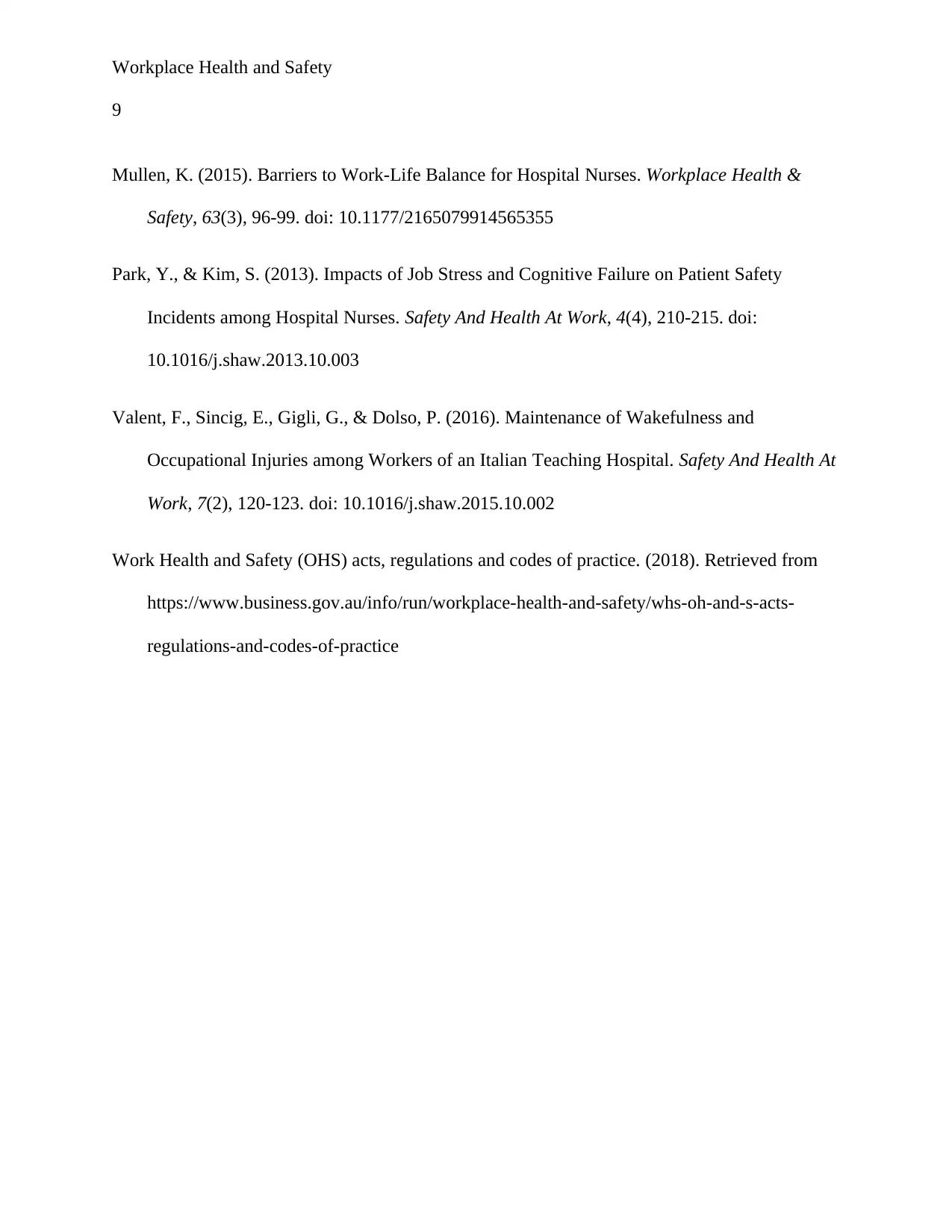
Workplace Health and Safety
9
Mullen, K. (2015). Barriers to Work-Life Balance for Hospital Nurses. Workplace Health &
Safety, 63(3), 96-99. doi: 10.1177/2165079914565355
Park, Y., & Kim, S. (2013). Impacts of Job Stress and Cognitive Failure on Patient Safety
Incidents among Hospital Nurses. Safety And Health At Work, 4(4), 210-215. doi:
10.1016/j.shaw.2013.10.003
Valent, F., Sincig, E., Gigli, G., & Dolso, P. (2016). Maintenance of Wakefulness and
Occupational Injuries among Workers of an Italian Teaching Hospital. Safety And Health At
Work, 7(2), 120-123. doi: 10.1016/j.shaw.2015.10.002
Work Health and Safety (OHS) acts, regulations and codes of practice. (2018). Retrieved from
https://www.business.gov.au/info/run/workplace-health-and-safety/whs-oh-and-s-acts-
regulations-and-codes-of-practice
9
Mullen, K. (2015). Barriers to Work-Life Balance for Hospital Nurses. Workplace Health &
Safety, 63(3), 96-99. doi: 10.1177/2165079914565355
Park, Y., & Kim, S. (2013). Impacts of Job Stress and Cognitive Failure on Patient Safety
Incidents among Hospital Nurses. Safety And Health At Work, 4(4), 210-215. doi:
10.1016/j.shaw.2013.10.003
Valent, F., Sincig, E., Gigli, G., & Dolso, P. (2016). Maintenance of Wakefulness and
Occupational Injuries among Workers of an Italian Teaching Hospital. Safety And Health At
Work, 7(2), 120-123. doi: 10.1016/j.shaw.2015.10.002
Work Health and Safety (OHS) acts, regulations and codes of practice. (2018). Retrieved from
https://www.business.gov.au/info/run/workplace-health-and-safety/whs-oh-and-s-acts-
regulations-and-codes-of-practice
⊘ This is a preview!⊘
Do you want full access?
Subscribe today to unlock all pages.

Trusted by 1+ million students worldwide
1 out of 9
Related Documents
Your All-in-One AI-Powered Toolkit for Academic Success.
+13062052269
info@desklib.com
Available 24*7 on WhatsApp / Email
![[object Object]](/_next/static/media/star-bottom.7253800d.svg)
Unlock your academic potential
Copyright © 2020–2025 A2Z Services. All Rights Reserved. Developed and managed by ZUCOL.





